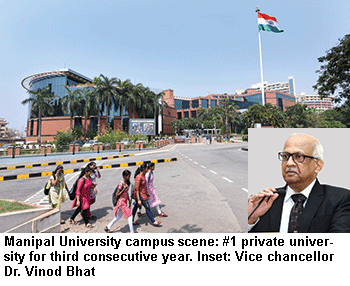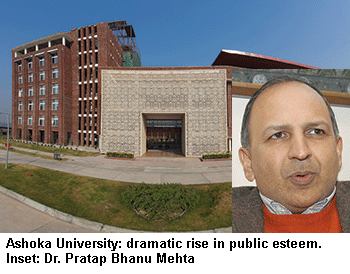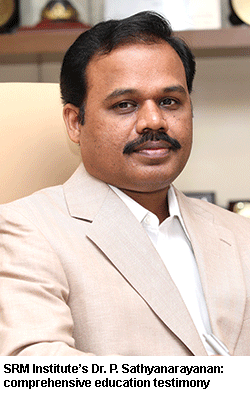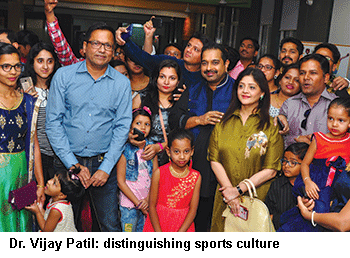Against the backdrop of a March 20 decree of the University Grants Commission conferring substantial autonomy on 52 institutions of higher education including 24 deemed and two private universities, the Delhi-based market research firm C fore constituted a 4,249-strong sample respondents database for the EW India Private University Rankings 2018-19 - Summiya Yasmeen
 THE 4,249 SAMPLE RESPONDENTS polled by Delhi-based market research firm C fore for the EducationWorld India Private University Rankings (EWIPUR) 2018-19 have voted the Manipal Academy of Higher Education (MAHE, estb.1953) — accorded the status of a deemed (private) university in 1993 — India’s #1 private university for the third consecutive year. This top ranking has come at a propitious time for MAHE which after being permitted to assume the title of Manipal University for 11 years, has been obliged to revert to its academy status following a whimsical UGC (University Grants Commission) decree of November 29, 2017 applicable to all private varsities.
THE 4,249 SAMPLE RESPONDENTS polled by Delhi-based market research firm C fore for the EducationWorld India Private University Rankings (EWIPUR) 2018-19 have voted the Manipal Academy of Higher Education (MAHE, estb.1953) — accorded the status of a deemed (private) university in 1993 — India’s #1 private university for the third consecutive year. This top ranking has come at a propitious time for MAHE which after being permitted to assume the title of Manipal University for 11 years, has been obliged to revert to its academy status following a whimsical UGC (University Grants Commission) decree of November 29, 2017 applicable to all private varsities.
Nevertheless, despite this seeming demotion, following a more recent (March 20) decree, it is one of 52 institutions of higher education conferred substantial autonomy by UGC. Under UGC’s “freedom charter”, these select 52 institutions (and eight autonomous colleges), highly rated by the Bangalore-based National Assessment and Accreditation Council (NAAC), will have the freedom to start new courses, establish off-campus learning centres, introduce new skills development programmes, hire foreign faculty, enroll foreign students, give incentive-based emoluments to faculty, enter into academic collaborations and run open distance learning programmes.
“I am delighted about MAHE being ranked India’s premier private university for the third consecutive year. We owe the high reputation of this institution to our faculty and students’ dedication to teaching, learning and research. I am especially pleased that we have been rated #1 on the parameter of infrastructure, and highly rated on the important parameters of research and innovation and diversity of study programmes. Now with UGC’s grant of autonomy, we will be able to start greenfield colleges, introduce new study programmes and establish learning centres quickly without prior regulatory approvals and red tape. We are also set to roll out a plan to establish three new colleges — a medical college in Jamshedpur, a campus offering new-age programmes such as humanities, business, management and art in Bangalore, and an international campus in Colombo. We are now looking forward to MAHE being included in the Central government’s list of ten private institutes of eminence which will receive government grants to meet more challenging goals. This will pave the way for MAHE to be ranked among the world’s Top 200 universities in the next five years,” says Dr. Vinod Bhat, FRCS and alumnus of Glasgow University who signed up with MAHE in 1988 and was appointed vice chancellor in 2015. Currently, MAHE provides medical, engineering, business and hotel management, pharmacy, nursing and paramedical education to 33,000 students in its 22 colleges.
Even as MAHE has retained its #1 seat at top table, further down the Top 10 league table of India’s premier 100 private universities there’s been a considerable churn. The Birla Institute of Science & Technology (BITS), Pilani  has inched up to second position (#3 in 2017) as has Vellore Institute of Technology to #3 (#4) followed by the new-genre Ashoka University, Sonipat, at #4 (#5). The previously #1 ranked Amity University, Noida is ranked #5 this year followed by the Thapar Institute of Engineering & Technology, Patiala and International Institute of Information Technology (IIIT), Hyderabad, jointly ranked #6. Tamil Nadu’s show-piece private universities — Amrita Vishwa Vidyapeetham, Coimbatore and SRM Institute of Science and Technology, Chennai — have retained their #8 rank even as Shiv Nadar University, Gautam Buddha Nagar (Uttar Pradesh) has debuted in the Top 10 league table.
has inched up to second position (#3 in 2017) as has Vellore Institute of Technology to #3 (#4) followed by the new-genre Ashoka University, Sonipat, at #4 (#5). The previously #1 ranked Amity University, Noida is ranked #5 this year followed by the Thapar Institute of Engineering & Technology, Patiala and International Institute of Information Technology (IIIT), Hyderabad, jointly ranked #6. Tamil Nadu’s show-piece private universities — Amrita Vishwa Vidyapeetham, Coimbatore and SRM Institute of Science and Technology, Chennai — have retained their #8 rank even as Shiv Nadar University, Gautam Buddha Nagar (Uttar Pradesh) has debuted in the Top 10 league table.
Yet perhaps the most dramatic rise in the esteem of the informed public in successive EWIPUR annual league tables, has been of the Sonipat (Haryana/Delhi NCR)-based Ashoka University (AU), promoted in 2014 as India’s first crowd-funded (90 major donors) liberal arts varsity.
Ranked #14 in 2015, it has steadily risen the EW league table from #9 in 2016 to #5 in 2017 and #4 this year. An American Ivy-League style university with 1,400 mainly undergrad students and 70 permanent faculty, since it admitted its first batch of 133 students in August 2014, AU has quickly established a reputation as India’s top liberal arts university and an acceptable substitute for super-expensive Ivy League varsities of the US.
We are very pleased with AU’s steady ascent up the annual EW league table. It shows the impact that Ashoka University’s distinctive approach — interdisciplinary education which equips students with 21st century skills including critical thinking, writing, communication and a spirit of public service — has made in just four years. Our high rating under faculty competence is acknowledgement that we recruit best faculty from around the world to mentor our high-calibre students from diverse backgrounds. We are also delighted to be ranked #1 on the parameters of curriculum and pedagogy, and leadership. Our approach to curriculum and pedagogy with strong emphasis on original thinking and peer learning represents a radical shift from the conventional model of teaching in India. On leadership, we have a well-defined, shared governance structure including committed founder-trustees, academic leaders and empowered faculty. We plan to scale up to 2,000 students by the year 2020. Apart from being a leading teaching university, Ashoka aspires to become a great research institution and we are investing significantly in that endeavour,” says Dr. Pratap Bhanu Mehta, vice chancellor of Ashoka University. An alumnus of Oxford and Princeton universities and former visiting professor of government at Harvard, Mehta was hitherto president of the Centre for Policy Research, Delhi, and is the author of several scholarly tomes — Burden of Democracy (2003); The Oxford Companion to Politics in India (2010) among others. Widely acknowledged as one of the country’s foremost public intellectuals, Mehta was appointed vice chancellor of AU in 2017.
 Dr. P. Sathyanarayanan, president of the SRM Institute of Science and Technology, Chennai, is also satisfied that the 33-year-old multidisciplinary university is ranked among India’s Top 10 private varsities for the second year in succession. “It is heartening that our sustained effort to provide high quality education is appreciated by our peers. I am particularly pleased that we have done well across the board under all your parameters — teaching and learning, research, and employability of graduates. This is testimony that we are a comprehensive university providing holistic education to students. The future is also encouraging. We have recently established a Directorate of Research and new research centres to boost faculty and student research. Moreover, SRM has collaborations with 100-plus international universities including MIT, Boston, UC Berkeley, Carnegie Mellon, Pittsburgh, etc to provide international exposure to our students,” says Sathyanarayanan, an alumnus of Anna University, Chennai, Northeastern University, USA and Southern Cross University, Sydney who served a term as vice chancellor (2003-2010) of this varsity sited on a state-of-the-art 600 acre campus in Kattankulathur, near Chennai, with an aggregate enrolment of 38,000 students mentored by 2,600 faculty.
Dr. P. Sathyanarayanan, president of the SRM Institute of Science and Technology, Chennai, is also satisfied that the 33-year-old multidisciplinary university is ranked among India’s Top 10 private varsities for the second year in succession. “It is heartening that our sustained effort to provide high quality education is appreciated by our peers. I am particularly pleased that we have done well across the board under all your parameters — teaching and learning, research, and employability of graduates. This is testimony that we are a comprehensive university providing holistic education to students. The future is also encouraging. We have recently established a Directorate of Research and new research centres to boost faculty and student research. Moreover, SRM has collaborations with 100-plus international universities including MIT, Boston, UC Berkeley, Carnegie Mellon, Pittsburgh, etc to provide international exposure to our students,” says Sathyanarayanan, an alumnus of Anna University, Chennai, Northeastern University, USA and Southern Cross University, Sydney who served a term as vice chancellor (2003-2010) of this varsity sited on a state-of-the-art 600 acre campus in Kattankulathur, near Chennai, with an aggregate enrolment of 38,000 students mentored by 2,600 faculty.
Further down the EWIPUR 2018-19 Top 100 league table, several varsities have risen in the esteem of the informed public. Among them: Azim Premji University, Bangalore, which has moved up to #17 (#20 in 2017), Sri Ramachandra Medical College and Research Institute, Chennai, ranked #24 (27), Dr. D.Y. Patil Vidyapeeth, Navi Mumbai, at #32 (34) and Datta Meghe Institute of Medical Sciences, Wardha at #37 (51).
Promoters, vice chancellors and faculty of varsities which haven’t made it into the Top 10/20 can derive comfort from high state rankings. And given that some of India’s 29 states are larger and more populous than the average European country, high ranking in state league tables is not to be disparaged.
For instance, KIIT University, Bhubaneswar, ranked #15 nationally is ranked #1 in the eastern seaboard state of Odisha (pop. 41 million); GITAM (Gandhi Institute of Technology and Management) University in the port city of Visakhapatnam, ranked #28 nationally, is top ranked in the southern state of Andhra Pradesh (pop. 52 million), and Amity University, Raipur ranked #97 in the national league table is ranked #1 in Chhattisgarh (pop. 28 million).
 Dr. Vijay D. Patil, a computer engineering graduate of Mumbai University and president of D.Y. Patil University, Navi Mumbai, ranked #3 in Maharashtra (pop.112 million), is pleased that the varsity is improving its national and state rankings. “We are satisfied with our high ranking in Maharashtra, India’s most industrial state. I thank the vice chancellor and heads of all institutions who have helped to live the vision of the university and congratulate them for this success. Education, healthcare and sports are the three pillars of our university. In fact one of our most distinguishing features is our strong promotion of a sports culture. We have an international-standard sports stadium with multiple facilities. I believe this focus on sports education has helped us produce well-rounded students who have succeeded in industry and the professions. Innovation and application of new technologies is also very important for us. We have integrated online and digital resources to connect students with faculty to radically transform classroom teaching and improve student learning outcomes,” says Patil.
Dr. Vijay D. Patil, a computer engineering graduate of Mumbai University and president of D.Y. Patil University, Navi Mumbai, ranked #3 in Maharashtra (pop.112 million), is pleased that the varsity is improving its national and state rankings. “We are satisfied with our high ranking in Maharashtra, India’s most industrial state. I thank the vice chancellor and heads of all institutions who have helped to live the vision of the university and congratulate them for this success. Education, healthcare and sports are the three pillars of our university. In fact one of our most distinguishing features is our strong promotion of a sports culture. We have an international-standard sports stadium with multiple facilities. I believe this focus on sports education has helped us produce well-rounded students who have succeeded in industry and the professions. Innovation and application of new technologies is also very important for us. We have integrated online and digital resources to connect students with faculty to radically transform classroom teaching and improve student learning outcomes,” says Patil.
In the pages following, we present the Top 100 EWIPUR league table followed by state league tables. Moreover, to inform parents/students about the relative ratings of the Top 100 private universities under the ten parameters of academic excellence used in this exhaustive survey spread over four months, separate Top 10 parameter tables are presented on pp 54. Investing household savings in relatively more expensive private education is a life-changing decision and we recommend that the national, state and parameter league tables are studied carefully.